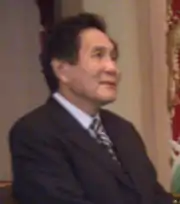1986 British Columbia general election
The 1986 British Columbia general election was the 34th general election in the Province of British Columbia, Canada. It was held to elect members of the Legislative Assembly of British Columbia. The sitting Social Credit government was re-elected.
| |||||||||||||||||||||||||||||||||||||||||||||
69 seats of the Legislative Assembly of British Columbia 35 seats were needed for a majority | |||||||||||||||||||||||||||||||||||||||||||||
|---|---|---|---|---|---|---|---|---|---|---|---|---|---|---|---|---|---|---|---|---|---|---|---|---|---|---|---|---|---|---|---|---|---|---|---|---|---|---|---|---|---|---|---|---|---|
| Turnout | 65.8%[1] | ||||||||||||||||||||||||||||||||||||||||||||
| |||||||||||||||||||||||||||||||||||||||||||||
| |||||||||||||||||||||||||||||||||||||||||||||
The election was called on September 24, 1986. The election was held on October 22, 1986, and the new legislature met for the first time on March 9, 1987.
The governing British Columbia Social Credit Party (Socreds) had seen a leadership change just months before the election, with Bill Bennett standing down in favour of Bill Vander Zalm. Promising a fresh start after the Bennett years, Vander Zalm led the Socreds to a fourth consecutive majority government, although with winning less than half of the popular vote. 12 new seats had been created in the legislature for this election. Social Credit coincidentally won 12 additional seats, while the social democratic New Democratic Party, led by Bob Skelly, won the same number it had in the previous election. No other parties won seats. This was the last election held before the mandated expiration of a parliamentary term, until 2020.
There were 17 two-member constituencies in this election, the last election to be held with them. Voters in these places were allowed two votes (block-voting), and generally used them both on the same party. Only two districts elected both a SC and a NDP MLA; all others elected either two SC-ers (12 districts) or two NDP-ers (three districts), with no representation given to the minority vote in the district. This helped ensure the government's capture of the most seats. (It also makes the "popular vote," the votes cast, not truly reflective of the sentiment of the voters, due to some voters casting two votes and others only one.)
Results
| 47 | 22 |
| Social Credit | New Democratic |
| Party | Party leader | # of candidates |
Seats | Popular vote | |||||
|---|---|---|---|---|---|---|---|---|---|
| 1983 | Elected | % Change | # | % | % Change | ||||
| Social Credit | Bill Vander Zalm | 69 | 35 | 47 | +34.3% | 954,516 | 49.32% | -0.44% | |
| New Democratic | Bob Skelly | 69 | 22 | 22 | - | 824,544 | 42.60% | -2.34% | |
| Liberal | Art Lee | 55 | - | - | - | 130,505 | 6.74% | +4.05% | |
| Progressive Conservative | Vacant[2] | 12 | - | - | - | 14,074 | 0.73 % | -0.43% | |
| Green | 9 | - | - | - | 4,660 | 0.24% | 0.05% | ||
| Independent | 6 | - | - | - | 2,470 | 0.13% | -0.19% | ||
| Libertas | 1 | * | - | * | 1,552 | 0.08% | * | ||
| People's Front | 8 | * | - | * | 1,502 | 0.08% | * | ||
| Communist | 3 | - | - | - | 722 | 0.03% | -0.02% | ||
| Libertarian | 3 | * | - | * | 341 | 0.02% | * | ||
| Western Canada Concept | Doug Christie | 1 | - | - | - | 322 | 0.02% | -0.84% | |
| New Republic | 1 | * | - | * | 245 | 0.01% | * | ||
| Total | 237 | 57 | 69 | +21.1% | 1,935,453 | 100% | |||
| Source: Elections BC | |||||||||
Note:
* Party did not nominate candidates in the previous election.
References
- "B.C. Voter Participation: 1983 to 2013" (PDF). Elections BC. Retrieved May 11, 2017.
- Party leader Peter Pollen quit shortly before the election was called
